Ultimate Itinerary for Iran
As well as this two-week itinerary for Iran, I have also created an Iran travel guide. It has recommendations for accommodation and lists the best sights to see in each city. Along with the guide, read my Iran Travel Blog. My blog contains a lot of my photography and has a more in-depth look at some of the best spots.
While the audience on BackpackerTrack is made up of mostly budget travellers and backpackers, this itinerary is absolutely ideal for everyone!
Day 1-2: Tehran
My travel guide to Tehran has recommendations for accommodation, food and transport.
Tehran Itinerary
Day 1: After arriving in Tehran and checking in to your accommodation I recommend heading into the city centre and visiting Golestan Palace, the Former US Embassy as well as the Azadi tower. While in the centre you can also head to Ferdowsi Square and change some money.
Day 2: Jump on the metro and make your way to Tajrish Station in the north of Tehran. From here you can visit the Niavaran Complex as well as head up to Mount Tochal.
Sights to See in Tehran
Golestan Palace
The Golestan Palace was the royal residence of the Qajar dynasty, rulers in Iran until 1925 when the Pahlavi dynasty took over. The Complex consists of 17 palaces, museums, and halls. A typical visit costs about 8€ for entry to the gardens plus one other main building.
Former US Embassy
Diplomatic relations between the two governments were severed after the Iranian Revolution in 1979, and subsequent seizure of the embassy in November 1979 and the Iran hostage crisis. The former embassy now houses a museum, the US Den of Espionage.
Azadi Tower
The Azadi Tower is a famous monument in Tehran and one you will likely have seen many pictures during research for your trip. It is definitely worth a visit.
Niavaran Complex
After the Qajar dynasty ended, the royal residence was moved to Niavaran house for the Pahlavi dynasty. The complex contains several old palace buildings, a museum and gardens. Niavaran Complex is located about 4km from the Tajrish metro station.
Mount Tochal
There is a recreation area on Mount Tochal that offers hiking trails, a ski resort, gym and other activities. It's also a great place to get some scenic views over Tehran and enjoy a little peace and quiet in contrast to the bustling city. Usually, people get to the top using the cable car. If going to the top, bring a jacket, even in summer, as the summit is 4,000 m above sea level so it can be chilly.
Getting from Tehran to Kashan
Make your way to the South Bus Terminal in Tehran. This terminal is conveniently located next to a metro station on the no. 1 line, it is called Terminal-e Jonoob or also known as South Terminal. When someone asks you where you want to go, tell them Kashan. They will then direct you to the correct counter. Tickets will cost about 5€.
Day 3-5: Kashan
My travel guide to Kashan has recommendations for accommodation, food and transport.
Kashan Itinerary
Day 3: Your first day in Kashan can be spent visiting the Sultan Amir Ahmad Bathhouse and the three historic houses during the morning. In the afternoon, catch a taxi out the Fin Gardens before heading back to your accommodation for the night.
Day 4: Organise a day trip out to Abyaneh through your accommodation or with a local taxi. You will visit a few other places on the way to Abyaneh and should be back to Kashan in the mid afternoon. When you get back, head to the Kashan Bazaar and find the Caravanserai at its centre.
Day 5: Organise a day trip out to the Maranjab Desert. This trip will take the better part of the day.
Sights to See in Kashan
Sultan Amir Ahmad Bathhouse
This bathhouse has been expertly restored and filled with well-placed artificial lighting providing some really good photo opportunities. It would be lovely to be able to see it in use as a bathhouse, alas it is now merely a museum. After visiting the interior, make sure you head to the roof. From here you will get to see the skylights used to light up the interior and get a fantastic view of Kashan as well as the surrounding mountains.
Historical Houses
There are three famous historical houses in Kashan that can be visited. They are the Borujerdi, Abbasian and Tabatabaei historical houses. Built during the 18th and 19th centuries, these houses possess classic features in traditional Persian residential architecture. Most of the beautiful Persian architecture in Iran exists in the Mosques, but here you get a great opportunity to see it in a residential setting.
Fin Gardens
The Bagh-e Fin is one of the most famous gardens in Persia and since 2012 a UNESCO world heritage site. Some of these trees are over 400 years old and a tremendous amount of care has been taken to keep them alive in the deserts of Iran. Within the Fin Gardens is a fresh water spring fed by the nearby mountains. Surprisingly, it seems to be a hot spring as the water is steaming as it flows through the gardens and feels around 30°C to touch.
Bazaar and Caravanserai
One of my favourite spots in Kashan was the caravanserai located inside Kashan Bazaar. As you enter the Aminoddole Caravanserai, the corridors of the bazaar suddenly open out into a masterpiece of Persian architecture. What I liked most about this space, is that it is not a mosque, museum or a historical house that requires a fee to enter. It is just a public space within a bazaar where people sell carpets and drink tea.
Abyaneh
Abyaneh is a village located about 80km south of Kashan. Abyaneh is an isolated town, particularly in the winter when snow and ice make it difficult to reach. Because of this, Abyaneh has developed a unique culture. Many elderly residents speak Middle Persian, an earlier incarnation of Farsi that largely disappeared centuries ago. The local clothing is also unique and consists of a long scarf with a colourful floral design. Abyaneh is characterised by a peculiar reddish hue that comes from the mud bricks quarried from the mountains nearby.
Maranjab Desert
The Maranjab desert is about 60km from Kashan and can be easily visited as either a day trip from Kashan. I have heard mixed reviews of the overnight stay and only went on a day trip myself. A trip out to the desert will normally include a visit to Namak Salt Lake as well as sand dunes in the desert.
Getting from Kashan to Isfahan
Make your way to the South Bus Terminal in Tehran. This terminal is conveniently located next to a metro station on the no. 1 line, it is called Terminal-e Jonoob or also known as South Terminal. When someone asks you where you want to go, tell them Kashan. They will then direct you to the correct counter. Tickets will cost about 5€.
Day 6-8: Isfahan
My travel guide to Isfahan has recommendations for accommodation, food and transport.
Isfahan Itinerary
Day 6: Arrive in Isfahan and after checking in, head to the Naqsh-e Jahan Square. While walking around the square you can head into the Shah Mosque
Day 7: Head back to Naqsh-e Jahan Square and this time when you're done walking around, check out Sheikh Lotfollah Mosque and Ali Qapu Palace.
Day 8: Take a walk down the main street, Chahar Bagh e Abbasi, towards the river and check out the bridges of Isfahan. Afterwards, continue walking towards the Jolfa District. Grab a coffee and make sure to visit the Vank Cathedral. When you're finished you can use bus route 91 to get back the city centre.
Sights to See in Isfahan
Naqsh-e Jahan Square
Naqsh-e Jahan Square is located in the centre of Isfahan and to me, feels like the centre of the country. I had a strong, 'well this is Persia' moment sitting here. The square attracts people from all over Isfahan to walk around, mingle, make friends and relax. While it's worth visiting just for the square alone, the real reason you absolutely must visit is that situated around the perimeter of the square are the Sheikh Lotfollah Mosque, the Shah Mosque and the Ali Qapu Palace.
Sheikh Lotfollah Mosque
The Sheikh Lotfollah Mosque is located on the eastern side of Naqsh-e Jahan Square and was the first built of the famous buildings bordering the square. This mosque was purposed as a private mosque of the royal court, unlike the Shah Mosque, which was meant for the public. For this reason, the mosque does not have any minarets and is of a smaller size. When the doors were opened to the public, centuries after it was built, ordinary people could finally see the exquisite tile work, which is far superior to those covering the Shah Mosque.
Shah Mosque
The Shah Mosque, also known as Imam Mosque since the Iranian revolution, is located on the south side of Naqsh-e Jahan Square. Built during the Safavid Empire, it is regarded as one of the masterpieces of Iranian architecture and an excellent example of Islamic era architecture of Iran. Its construction began in 1611 and was completed in 1629. The beauty of the Shah Mosque comes from its seven-colour mosaic tiles and the calligraphic inscriptions from the Koran.
Ali Qapu Palace
Ali Qapu, also known as The Great Persian Palace, is a grand palace located on the western side of the Naqsh e Jahan Square, opposite to Sheikh Lotfollah Mosque. It is forty-eight meters high and there are six floors, each accessible by a spiral staircase. Ali Qapu was repaired and restored substantially during the reign of Shah Sultan Hussein, the last Safavid ruler, but fell into a dreadful state of dilapidation again during the short reign of invading Afghans.
Bridges of Isfahan
Isfahan is famous for its many bridges across the Zayande River. The bridges over the river include some of the finest architecture in Isfahan. The oldest bridge is the Shahrestan bridge but the closest bridge to the centre of Isfahan is Si-o-Seh Pol Bridge and it is also the longest. The other bridges worth visiting are all downstream (east) from here.
Jolfa
Jolfa is the Armenian quarter of Isfahan, located along the south bank of the Zayande River. Of particular note is stunning Vank Armenian Cathedral, I have posted a few photos of the Vank Cathedral below. Jolfa has existed as an Armenian quarter for over 400 years and was an important base of operations for Armenian traders on the silk road. Today it is a very stylish and relaxing district with the highest concentration of cafes (with decent WiFi!) anywhere in Iran.
Getting from Isfahan to Shiraz
Shiraz can be reached from Isfahan very easily by VIP bus. These buses depart from Kaveh Bus Terminal located just north of the city centre. Just take bus 91 north to get to the bus terminal. Tickets should be around 200,000 IRR (5€). Just walk in and ask around for a bus to Shiraz and you will be directed to the correct counter. If the bus they offer doesn't leave for a long time, make sure to check other counters for earlier departure times.
Day 9-11: Shiraz
My travel guide to Shiraz has recommendations for accommodation, food and transport.
Shiraz Itinerary
Day 9: Check in and then catch a taxi out to the Eram Gardens.
Day 10: Join a tour group to visit Persepolis and the Necropolis as well as Pasargadae.
Day 11: Get up nice and early and head to the Pink Mosque as soon as it opens so that you can get the best photos of the sunlight through its stained glass windows. Afterwards, head to the Vakil Mosque and then in the afternoon finish the day with a tour during sunset at the Shah Cheragh Holy Shrine.
Sights to See in Shiraz
Eram Gardens
Eram Gardens are on the UNESCO World Heritage List and is a stunningly beautiful complex containing a vast network of gardens. It is quite similar to the Fin Gardens found in Kashan. Entrance to the gardens is 200,000 IRR (5€) but you will also need to take a taxi to get there as Eram Gardens is located about 5km from the hostels and city centre. Taxi fare should be around 60,000 IRR (1.5€)
Persepolis and the Necropolis
If you come to Shiraz, you have to visit Persepolis, the capital of Ancient Persian Achaemenid Empire. An empire that stretched an astonishing distance from Greece and Libya in the west to and Afghanistan and Pakistan in the east. At its peak it controlled more land area than the Roman Empire, Ottoman Empire or Ancient Macedonia did at their peaks while pre-dating all of them. The Achaemenid Empire was ultimately brought down by the conquering of Alexander the Great who burnt Persepolis down in 330BC.
Pasargadae
Prior to the construction of the city of Persepolis, for a period the capital of the Achaemenid Empire was at Pasargadae. Cyrus the Great began its construction in 559BC and today it is also where his tomb is found as seen in the image below. The tomb of Cyrus is the main reason for visiting Pasargadae. Generally speaking, the ruins are not as well preserved or impressive as those of Persepolis. Upon requests, tours of Persepolis can include a trip to Persepolis.
Pink Mosque (Nasir Al-Molk Mosque)
For some, the Nasir Al-Molk Mosque is not just a thing to see in Shiraz, but one of the reasons they visit Iran in the first place. It's a bucket list worthy item. The entrance opens at about 7:30 am and my advice is to arrive exactly at that time. It is not uncommon for large groups of tourists to arrive at once and take over the Mosque. Don't be afraid to ask other tourists to politely move their jackets, cameras out of the way if they are ruining your shots and shepherd them down towards to entrance of the Mosque so that you may be able to take shots like the one below.
Shah Cheragh Holy Shrine
Shah Cheragh is very much an active pilgrimage site in Iran. Iranians come here in their droves to pay their respects. Shah Cheragh is a funerary monument housing the tomb of the brothers Ahmad and Muhammad, sons of Musa al-Kadhim and brothers of Imam Reza, the 7th of 8th Imams in Shia Islam. Entrance to the shrine is free, however, you will need to be guided through the site. The guides are very friendly and approachable people. Visit in the evening, just before sunset, for some great photos.
Vakil Mosque
The Vakil Mosque is one of many beautiful mosques that you will see in Iran. Vakil Mosque is located very close to a Vakil Bathhouse and Bazaar, two other places that you can consider visiting in Shiraz. The entrance fee here is 150,000 IRR (4€). Considering Shah Cheragh is free if you only visit one mosque in Shiraz (other than the Pink Mosque obviously) visit Shah Cheragh instead. Still, Vakil Mosque is beautiful!
Getting from Shiraz to Yazd
Buses to Yazd can easily be found from Karandish Bus Terminal. A taxi to the bus terminal from most hotels should be no more than 60,000 IRR. The VIP bus ticket to Yazd should be priced at around 200,000 IRR (5€). I suggest arriving a bit earlier in the day for your tickets as Yazd is a little harder to get tickets to in comparison with Isfahan.
Day 12-14: Yazd
My travel guide to Yazd has recommendations for accommodation, food and transport.
Yazd Itinerary
Day 12: After checking in, take a walk around the city and visit the Jameh Mosque and Amir Chakhmaq Complex.
Day 13: Organise a day trip out to Kharanaq, Chak Chak and Meybod
Day 14: Catch a taxi out to the Towers of Silence on the outskirts of the city. Make sure to arrange a return taxi trip before you enter if you are there for the sunset. Otherwise, you might be stranded.
Sights to See in Yazd
Kharanaq
Kharanaq, a 4,000-year-old abandoned town, is located 70 km from Yazd. Kharanaq is a city built entirely out of mud brick’s and has been inhabited for 4,000 years. The drive out to Kharanaq is very pleasant. Lots of mountains towering over the desert landscape. I was informed by my the driver that this area of Iran reaches peak temperatures over 50°C in summer!
Chak Chak
Chak Chak is a small village in the mountains of Iran close to Yazd. It is also a Zoroastrian fire temple and the most sacred of the mountain shrines of Zoroastrianism. The story goes that Nikbanou, second daughter of the last Persian ruler, Yazdegerd III of the Sassanid Empire, fled here under attack by an Arab army in 640 CE.
Meybod
Meybod is an ancient city that dates back to the pre-Islamic era of Iran. A visit to Meybod is often included in tours that visit Kharanaq and Chak-Chak. The centrepiece of Meybod and the reason that it’s included in day trips is the Narin Qal’eh castle. Narin Qal’eh is a mud brick fort built around 2000 years ago.
Towers of Silence
There are two Towers of Silence located on the outskirts of Yazd, 10km or 15mins drive from the city centre. Both of these towers can be seen in the image above. According to Zoroastrian tradition, dead bodies would be placed inside the pits atop the Towers and left exposed to the elements. As the bodies break down, carrion birds perform an excarnation of the bodies. The best time of the day to visit is around sunset. If you do, it is wise to speak to a taxi driver near the entrance and arrange for him to wait for you to finish and then take you back to your hotel/hostel afterwards.
Jameh Mosque of Yazd
The Jameh Mosque of Yazd, or Friday congregation mosque, is a nearly 700-year-old mosque. The mosque is a fine specimen of the Azari style of Persian architecture. The mosque is crowned by a pair of minarets. At 52m high, they are the highest in Iran, and the portal's facade is decorated from top to bottom in dazzling tile work, predominantly blue in colour.
Amir Chakhmaq Complex
The Amir Chakhmaq Complex is a prominent it structure in Yazd noted for its symmetrical sunken alcoves. It is also a mosque located in the square of the same name. It also contains a caravanserai, a bathhouse, a cold water well, and a confectionery. At night, the building is lit up after sunset with orange lighting in the arched alcoves.
Getting from Yazd to Tehran
The Yazd Bus Terminal is located away from the centre of town. You will require a 12km taxi journey to reach it from the centre of Yazd. From the Yazd Bus Terminal, you can easily find buses to Tehran for 460,000 IRR. Note that this bus will stop in Kashan as well.

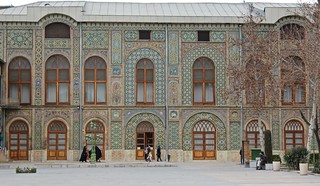
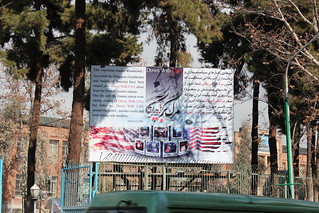
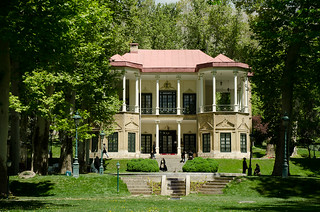
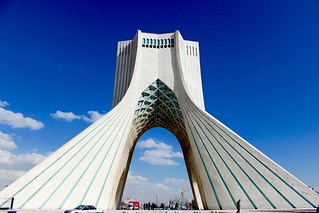
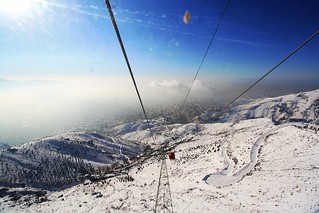
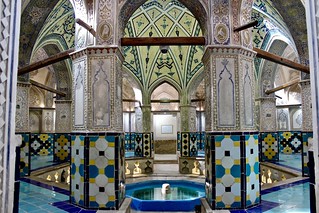
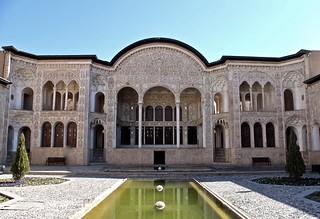
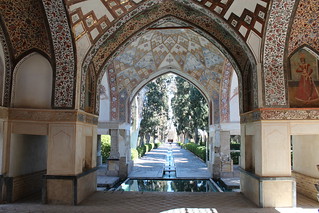
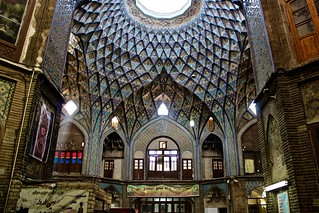
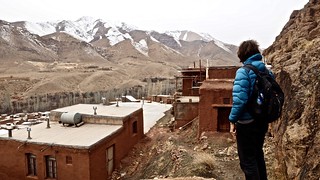
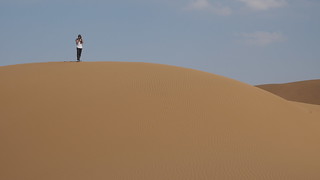
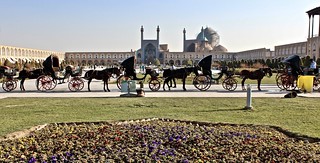
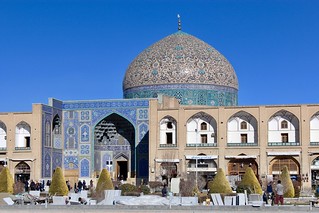
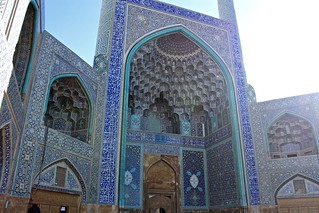
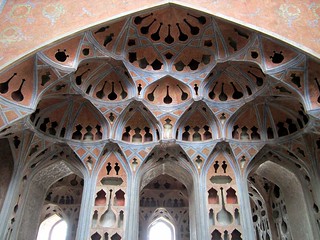
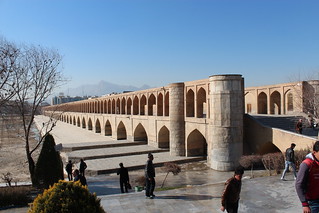
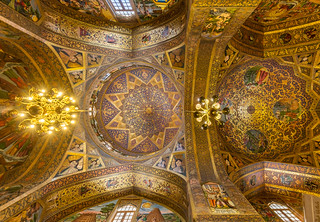
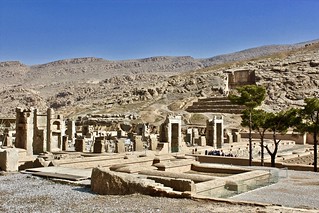
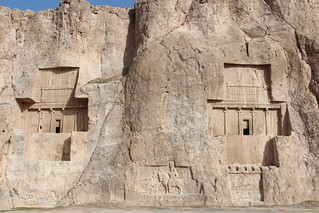
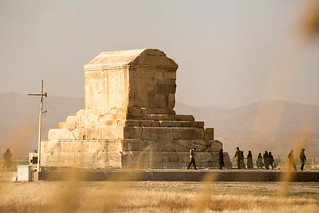
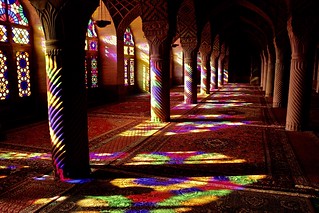
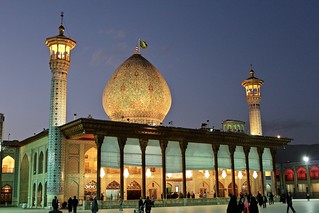
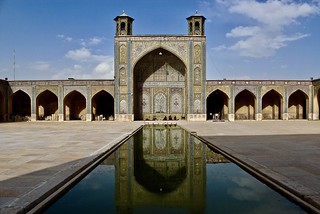
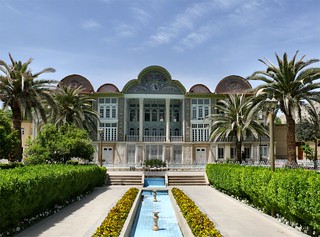
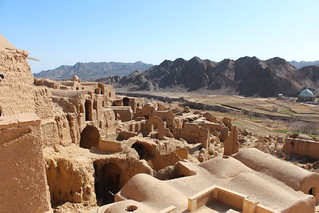
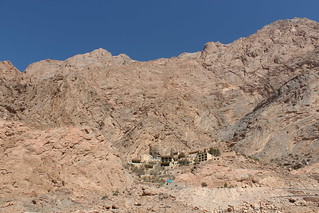

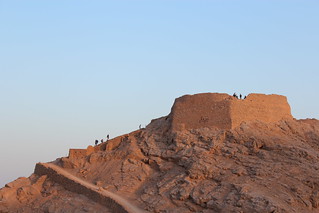
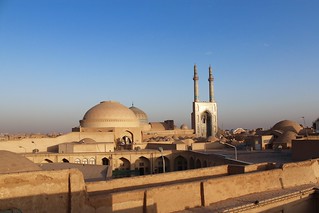

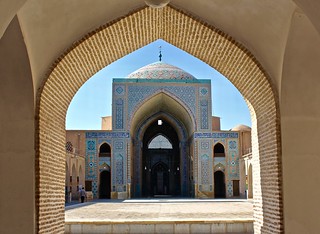
4 comments
Comment by Vincent
Vincent August 12, 2017 at 4:09 am
Hi Hayden,
Thanx for sharing your 2-week trip in Iran. I’m doing pretty much the same trip next month. Can you give me an idea the total budget for this 2-week journey (all inclusive, accomodation, transport, meals, tours)?
Vincent
Comment by Hayden
Hayden August 20, 2017 at 8:54 am
Hi Vincent,
My complete budget was 30 euro per day of travel. This excludes flights into or out of Iran, but includes all accommodation, transport, tours and food within the country. It was tough to keep it down that low. It’s definitely possible to do it for 30euro like I did, but having a bit spare for an emergency would be a great idea.
Comment by Tobio
Tobio September 16, 2017 at 7:44 am
Hi Hayden,
This is a nice write up. Very useful for me. Planning my trip to Iran in end nov.
Any idea if I have to book all my accommodations in advance?
Comment by Hayden
Hayden September 17, 2017 at 1:48 pm
Hi Tobio!
I was travelling during what felt like a pretty busy period but I still never really had any problems with finding accommodation. However, it is an emerging travel destination so things are constantly changing. There seemed to be 2-3 highly recommended hostels per city and the options would start to get pretty thin if they happen to be full.
My advice would be to book your accommodation for Tehran (or wherever you arrive) about 10 days in advance just in case. For the rest of your trip, 3-4 days in advance should be fine. I even saw quite a few people travelling with no bookings at all and they were fine as well.
Regards
Hayden